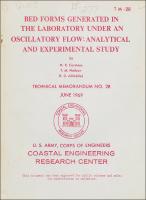Please use this identifier to cite or link to this item:
https://hdl.handle.net/11681/25687Full metadata record
| DC Field | Value | Language |
|---|---|---|
| dc.contributor.author | Carstens, M. R. (Marion Robert), 1919- | - |
| dc.contributor.author | Neilson, Frank Murray, 1938- | - |
| dc.contributor.author | Altinbilek, Hilmi Dogan, 1944- | - |
| dc.date.accessioned | 2017-11-30T21:29:21Z | - |
| dc.date.available | 2017-11-30T21:29:21Z | - |
| dc.date.issued | 1969-06 | - |
| dc.identifier.uri | http://hdl.handle.net/11681/25687 | - |
| dc.description | Technical Memorandum | en_US |
| dc.description.abstract | Various features of bed forms which occur in a bed of uniform sand were studied experimentally in an oscillatory-flow water tunnel. The amplitude of the water motion was a controlled variable. Three sizes of bed material were used in otherwise duplicate experiments. The period of oscillation was essentially constant in all runs. A flat bed was the initial condition in all runs. Initial and final transients were eliminated from the water motion. Experiments were organized to study (a) incipient motion, (b) evolution of a duned bed, (c) geometry of equilibrium dunes, and (d) energy dissipation in the flow over a duned bed. The incipient-motion condition was determined both on a duned bed and on a flat bed, and was analyzed by considering the lift, drag, and submerged weight forces on a typical particle on the bed surface. An analytical expression was derived for the critical velocity in terms of the ratio of specific weights of bed material and fluid, mean size of particle, angle of repose of bed material, bed slope, and a coefficient of drag (the magnitude of the coefficient of·drag depends upon the critical velocity, fluid viscosity, and particle size). This rational incipient-motion criterion proved satisfactory for the prediction of incipient motion under oscillatory flow both with a duned bed and flat bed. The criterion was applied to· two-dimensional, turbulent, unidirectional flow over a flat bed with a reasonable agreement with the results of other experimenters. As a result of this analysis, rational expressions were derived (for the first time to the authors' knowledge) for the widely used Shields diagram which is based upon experimental findings. The manner in which a flat bed evolves into a duned bed was observed. A ripple system forms spontaneously all over the flat bed if the maximum velocity is greater than the critical velocity. A ripple system can be induced to form with lesser velocities by a disturbance which creates a non-uniform flow zone just above the bed. Ripples will form and grow with the earlier formed dunes acting as a disturbance from which a new ripple will form. Celerity of an induced dune system was determined from experimental measurements. Geometry of equilibrium dunes was determined from side-elevation photographs and from point-gage traverses over the bed after a run. The\ ratio of dune amplitude to mean particle diameter and the ratio of dune amplitude to dune wave length were found to be unique functions of a single variable -ratio of water motion amplitude to mean particle diameter. If the amplitude-to-diameter ratio is less than 775, the dunes are two dimensional with essentially straight and level crests and troughs. If the amplitude-to-diameter ratio is greater than 1700, the bed is flat regardless of the initial condition. In the intermediate range from 775 to 1700 the dunes are three dimensional with ill-defined crests and troughs. Dune amplitude decreases almost linearly with increasing water-motion amplitude in the range of three-dimensional dunes. The added energy dissipation with oscillatory flow over a duned bed was compared with oscillatory flow over a smooth flat bed by measurements of work input into the tunnel. Results were analyzed and presented in terms of the difference in boundary drag coefficients between the duned bed and the smooth flat bed. Drag-coefficient values appeared to be abnormally large in comparison with drag coefficients determined in other flow situations. The apparent discrepancy was traced to the existence of an essentially uniform velocity distribution above the bed in oscillatory flow in contrast to the non-uniform velocity distribution above the bed in unidirectional flow. The magnitude of boundary-drag coefficients computed from experimental measurements is obviously greatly influenced by the choice of a reference velocity. The conclusion is that a velocity in the vicinity of the bed deformation is a more rational reference than a velocity far from the bed such as the mean velocity in unidirectional flow. | en_US |
| dc.language.iso | en_US | en_US |
| dc.publisher | Coastal Engineering Research Center (U.S.) | en_US |
| dc.relation.ispartofseries | Technical Memorandum (Coastal Engineering Research Center (U.S.));no. 28 | - |
| dc.rights | Approved for public release; distribution is unlimited. | - |
| dc.source | This Digital Resource was created from scans of the Print Resource. | - |
| dc.subject | Sand | en_US |
| dc.subject | Sand dunes | en_US |
| dc.title | Bed forms generated in the laboratory under an oscillatory flow : analytical and experimental study | en_US |
| dc.type | Report | - |
| Appears in Collections: | Technical Memorandum | |
Files in This Item:
| File | Description | Size | Format | |
|---|---|---|---|---|
| CERC Technical Memorandum No 28.pdf | 15.66 MB | Adobe PDF |  View/Open |